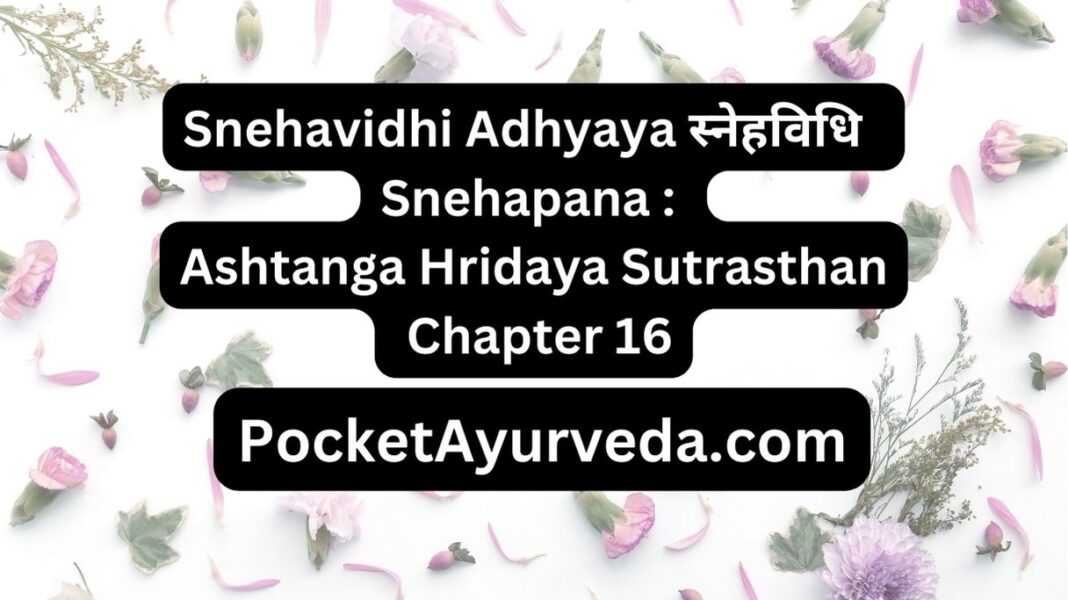We will go over in detail the process of Snehana treatment with drinking fat that is given just prior to performing Emesis (Vamana) and Purgation (Virechana) The Panchakarma treatment. The 16th Chapter in Ashtanga Hrudaya Sutrasthana is called Snehavidhi Adhyaya.
Snehana Dravya Guna – Qualities of oils and fats
Snehana Dravya Guna


The Snehana compounds used in oleation therapy, are characterized by the following characteristics:
- Guru – weightiness
- Sheeta – cold
- Sara – effortlessly moving with ease, mobility, spreading
- Snigdha – unctuous, oily
- Manda – mild,
- Sookshma – minute
- Mrudu – soft
- Dravam – liquid
The chemicals used to give an aridity to your body (Rookshana) have different characteristics to the ones mentioned above.
Sneha Dravya – Oleating substances
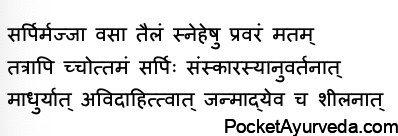

Sneha Dravyah – Oleating substances
Sarpi (ghee and unclarified butter),
Majja (bone marrow),
Vasa is muscle fat and
Taila (oil) is considered the most effective among oleating substances. In this group,
Ghee is the best. Because,
Madhura is sweet and delicious
Avidahi doesn’t cause burning sensations
Janmadyeva sheelanat is a good fit for the body from the time of birth. 2 – 3a.
Ghee is the most effective for pitta


In all of the three, Ghee is the most efficient in Pitta balance, while Taila is the least effective on the subject.Chatursneha


When compared to the other four, ghee is extremely easy to digest. Oil is much heavier (hard for digestion) than ghee. Muscle fat is much heavier than oil, and marrow is heavier than the rest.
Yamaka Sneha


The mixture of two different oleating substances is referred to as Yamaka. The mixture of three is referred to as Trivrit and
All four of them are referred to as Mahasneha. 4b.
Snehyah – people who are suitable for snehapana – oleation :
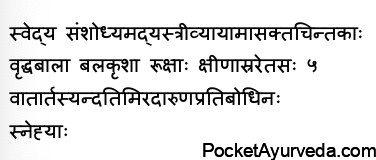

people who are suitable for oleation Snehyah .
- Patients who require Snehana therapy include –
Svedya Samshodhya, Svedya who require cleansing and sudation therapies, - Madya, Stree, Vyayama and asakta, who indulge more in women, wine and fitness;
Chintaka – who thinks too much,
Vruddha – the old,
Bala
Abala – the crippled,
Krusha is the one who has a swollen, fatigued
Ruksha – dry,
Ksheena asra retas depleted semen and blood,
Vatarta sufferers from illnesses of Vata,
Timira – blindness, ophthalmia
those suffering from chronic disorders.
Asnehya – people unsuitable for Snehapana – oleation :
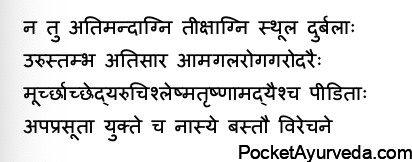

Asnehya – individuals who aren’t suitable for Oleation
Patients who shouldn’t be treated with Snehana include:
- Atimandagni Patients with very weak digestion.
- Teekshnagni or extremely powerful digestive power
Sthula – obese - Durbala is very fragile
- Urustambha – stiffness in the thighs
Atisara – diarrhea, dysentery
Amaroga, indigestion Ama condition or altered metabolism
Galaroga – throat-related diseases
Gararoga – Chronic poisoning
The Murcha is fainting and then losing consciousness
Chardi – Vomiting
Aruchi – anorexia
Shleshmaroga – the disease of Kapha imbalance
Trushnaroga – – excessive thirst
Madyapeedita – chronic alcohol
Apaprasuta is a lady who’s had an abortion
Nasya, Basti, Virechana – people who claim to be taking nasal medicine or enema, as well as purgative therapies. 6-8a.
Ghrita Yogya:


Ghrita (ghee) is the best for those who want
improvement of memory, intelligence, etc. 8b.
Taila Yogya:


- It is known as Taila (oil) is used to treat illnesses such as
Granthi – tumor,
Nadi roga – sinus, ulcer
Krumiroga – worms
Shleshmaroga-related diseases Kapha inequities - Medoroga – overweight
- Marutaroga – Infections due to the imbalance of Vata
for those who wish to see thinning and strength of the body, as well as those who experience difficult bowel movements. 9.
Vasa Majja Yogya:
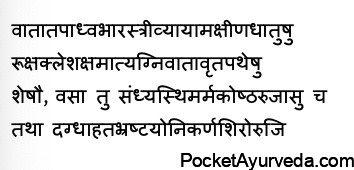

- Vasa along with Majja – Marrow and Muscle-fat are suitable for people
Vatatapa – who have been exhausted of their tissues due to exposure to sunlight, exposure to breeze and long distances walk, carry heavy loads, women (sexual activities) or physical exercises
Ruksha is a dry group of people who are able to withstand stress, have powerful digestive functions and in whom Vata is blocked in its normal channels.
Vasa Muscle-fat is suitable for joint pain bone, vital organs, and abdominal viscera as well as for burns, pain and assault by weapons vagina prolapse (prolapsed) or earache and headaches. 10 – 11.
Oil is perfect for the use of Pravrit Ghee at the last week of Varsa


Oil is perfect for use during Pravrit (the first rainy season).
Ghee is a great option for the last days of Varsa i.e. the Sharat-autumn.
The other ones are occur during Madhava i.e. Vasantha-spring.
Snehayogya Kala – the right timing for Oleation therapy
Snehayogya Kala – the right timing for Oleation therapy


In High temperate weather, the using oleating substances should be carried out during the daytime and only when the sun is shining. 12b.


Oil can be used in an emergency, even during cold weather, and with ghee even in summer and at night. 13a.


In the case of diseases caused by an increase in Pitta as well as Vata and their association with the dominance of Pitta Vata – ghee must be avoided at night and during summer. 13.


Other than that, illnesses caused by Vata and Kapha result when fats are consumed at night as well as diseases of Pitta when they are used during the daytime. 13 – 14a.
Sneha Samkhya – Numerous Oleation recipes


Recipes for Oleation – Sneha Samkhya
It is important to use fats in a proper manner when mixed with chewable or other types of food or as nasal drops, enemas, or nasal ointments applying oil to the body, putting it within the mouth and then putting it on top of the head, in the eyes and ears. 14b – 15a.


When it is combined with other ingredients with different tastes, and also without mixing, it will result in sixty-four numbers of recipes.
Vicharana Sneha
Use of fat in food is not very effective – it’s mild due to its mixing with other ingredients and due to its smaller amount. 15b – 16a.
Acchapeya Sneha


Acchapeya Sneha is the act of consuming fats or oils without mixing them with food items. Sneha Vicharana refers to eating when food items are mixed with.
The acchapeya technique of applying fats is believed to be the most effective because it fulfills the purpose of fats and provides fast lubrication. 16b – 17a.
Acchapeya Sneha:-


Acchapeya Sneha
The amount of fats consumed depends on the digestive capacity and the digestive activity of the individual.
The Heena matra (least dose) is the one that is digested in 2 yaama (6 Hours) (1 yaama equals 3 hours)
The moderate dosage (Madhyama matra) is the one which is digested in just three yama (9 hours). The highest dosage (Uttama matra) is the one that is digested in four yama (12 hours).
Hraseeyasi matra Snehapana
The minimum dosage is to be administered at the beginning, after taking into account the state of Dosha and so on. 17b – 18.
The Hraseeyasi matra refers to the minumum amount of sneha which is offered to the patient in order to assess the strength of digestion. After assessing the digestive power then the proper dosage of fat is determined.
Snehapanavidhi


Shodhanartha Snehapana
For Shodhana as a preparation method for the Panchakarma treatment, Acchasneha drinking fat should be done immediately after the digestion of food and at the maximum dosage.
Shamanartha Snehapana


For Shamana To help reduce Doshas in the treatment of an illness It is recommended to consume fats in times of hunger and without food. Fasting and in moderate doses. 19.
Brimhana snehapana
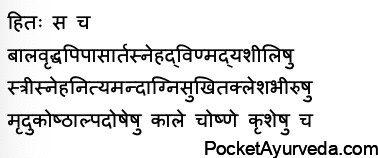

For Brimhana for weight loss treatment, it is served with meat soup or wine, etc. and eaten with food, in a smaller amount. 20a.
Mild Oleation
This type of mild oleation is suited for infants, the elderly and those who suffer from thirst, people who are allergic to fat, who consume drinks, alcohol, and fatty food items regularly, with a poor digestive capacity, and who lead a happy life, are not afraid of problems, have soft bowels with a low amount of – growth of Doshas in the summer months and for those who are thin. 20 – 21.
Snehapana for treatment of various diseases


When fats are utilized prior to meals, they are beneficial for treating diseases that affect the lower parts of our body. It helps strengthen the upper portion of the body.
When fats are consumed in the course of eating they can be beneficial in treating illnesses that affect the middle region in the human body. It helps strengthen the middle region and the middle part of our body.
When fats are consumed in conjunction with food intake they can be beneficial for treating diseases of the upper portion in the human body. It helps strengthen the lower portion and lower part of the body.22.
Sneha Upachara – Care after drinking fats
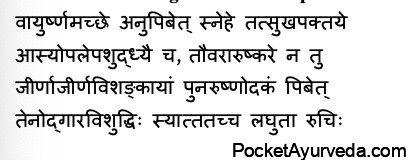

Sneha upachara – Care after drinking fats
After Acchapana (drinking of fat by itself) Warm water must be taken in.
It aids digestion and also helps to clear your mouth of its coating.
However, when you are you are taking Tuvaraka taila , or Arushkara taila (very hot in the natural world) drinking chilled water is recommended.
If you are unsure about the digestion of fats, warm water is recommended to drink in a second time;
purification of the stomach, clear belching, a feeling of lightness within the body, and a desire to eat food – these three signs indicate that the fat has been fully eliminated. 23 – 24.
Ritucharya adhyaya ऋतुचर्या Seasonal Regimen : Ashtanga Hridayam Chapter 3
Snehapana Diet


Dietary guidelines for fat consumption
Foods that contain liquid (drava) or warm (Ushna) and do not produce excess moisture in the body (anabhishyandi) but not overly fat-laden (na atisnigdha) and are not a mix of various food ingredients and should be consumed by the person in small quantities. 25
Regimen for Panchakarma Procedures
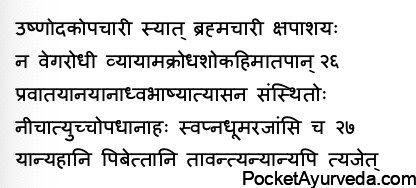

Regimen during and after snehapana
- Ushnodakopachari : The person should use only warm water in all of his activities.
- Brahmachari – He should maintain his celibacy.
- He should eat only during the need to eat is present.
- Na vegarodhi : should not resist natural urges,
- nor engage in physical exercise, anger and grief, or exposure to sunlight, cold and breeze, riding animals, driving in cars, walking for a long distances, doing too much talking, settling into uncomfortable positions for long periods maintaining a very low or very high pillows on one’s head. through the time, and in close exposure to dust and smoke when one drinks fats and for the exact number of days following. 26-28a.


The same regimen is used typically for all purification therapies like emesis, the enema, purgation and so on. as well as for those affected by illnesses. 28b.


If you are experiencing Shamana Sneha – palliative oleation therapy, the treatment regimen is recommended for the person who has been treated for purgation in chapter 18 must be used. 29a.
Acchapana Kala – Duration of Snehapana


Acchapana Kala – the duration of consumption of fat alone.
Acchapana is drinking fat alone.
three days for those who have soft bowels (Mrudu Koshta),
5 days for Madhyama Koshta, 7 days for those with hard bowels (Krura Koshta), or until the signs of good oleation begin to manifest.
Then, the fat is adapted to the patient and doesn’t produce the desired effects. 29b – 30a.
Samyak Snigdha Lakshana Signs of proper oleation – Samyak snehapana lakshana


Samyak Snigdha Lakshana – – signs of the oleation
Vatanulomana – Downward motion of Vata,
Deepto agni – keen digestive activity,
Vachaha Snigdham Asamhatam – Faeces becoming fat and non formed and not solid, Snehodvega – an aversion to fat Klama – exhaustion
These are signs of proper lubrication.
In contrast, they are dryness, Pallor, discoloration of yellowish white and the release of secretions from the mouth, nose and rectum are indications of excessive oil production. 30b – 31.
Snehavyapat Laksana – Negative results of improper oleation


Snehavyapat Laksana – negative consequences of snehapana that is not done correctly
Incorrect dosage of alcohol or type, in the wrong timing, or consuming inappropriate foods and activities causes hemorrhoids and edema. It can also cause stupor, rigidity, loss of motion, loss of feeling or unconsciousness, itching skin ailments as well as nausea, fever stomach pain dizziness, flatulence. 32 – 33a.
Snehavyapat Chikitsa – treatment for adverse effects of snehapana
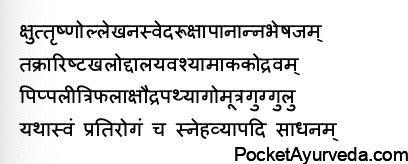

Snehavyapat Cikitsa – treatment of adverse effects
Kshut, Trushna – Producing thirst, hunger,
Ulleka, Sveda – vomiting and sweat,
using drinks, food and medicines that can be not dry (cause the sensation of being dry),
Utilization of Takrarista (fermented medicine made of buttermilk), Khala – menu made from curds, Uddala Yava (barley), Shyamaka, Kodrava, Pippali (long pepper), Triphala, Ksaudra (honey), Pathya (haritaki), Gomutra – cow urine, Guggulu and such others such as drugs, food items etc.
prescriptions For each illness are the treatments for those diseases that are caused by incorrect Snehana treatment. 33b – 35a.
Virukshana treatment to relieve dryness:


Virukshana is a treatment to treat dryness
The characteristics of both proper and excessive Viruksana dryness are identical to those of the excess and appropriate Langhana techniques of making the body appear thin. 35b.
The regimen of Panchakarma After Snehana –
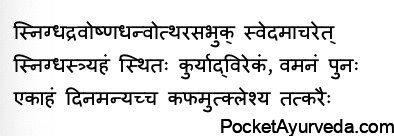

The regimen of Panchakarma was conducted following Snehana.
The patient must drink juice made from meat and other animals that are found in desert regions that are mixed with fats and making the liquid thin and warm.
Then, he should undergo sudation therapy (Swedana).
After three days of snehapana, he will be treated with purgation therapy.
After snehapana rest for a period of one day. Kapha should be increased by taking food items or drugs. which increase kapha and then emesis therapy is recommended. 36 – 37a.
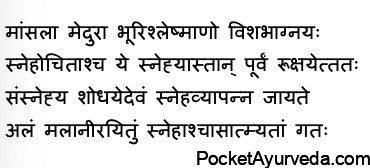

People who are strong and fatty, suffering from Kapha imbalance, or erratic digestion, who are used to fats, and who require Oleation therapy, must be made dry first by means of food, drugs, and other medications. and then given Oleation therapy, followed by purification treatments; with this method, complications from Oleation won’t develop. This procedure is sufficient to trigger the damaged Dosha to get rid of it 37b-39a.
Sadhya sneha Yoga – recipes for immediate oleation :-


Sadhya sneha Yoga – recipes for immediate oleation
For older, children, or elderly. Those who can’t stand the pain or avoidance of certain things during oleation therapy are able to use the following recipes that are Sadya sneha , which is immediate oil lubrication or oleation, and are not harmful. 39.
Sadya sneha Yoga
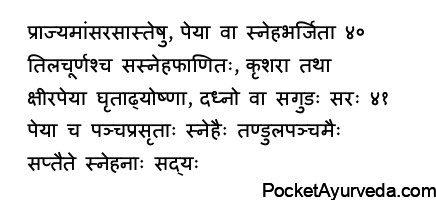

Juice of the meat is prepared from a larger amount of meat
Peya – gruels fried with more fats,
powder of Tila blended with fat and half-boiled the molasses (Phanita),
Krisara Rice – cooked rice along with green gram, mingled with the same ingredients as previously,
Ksheera peya Gruel is made from milk, which is mixed with a larger amount of butter-ghee, and fat and heated.
Dadhi Sara – yogurt water, whey from curds, mixed in Guda (jaggery),
Panchaprasruta Peya – a thin greek made from one Prasruta consisting of ghee, Sesame Oil, Muscle Fat the marrow along with rice (tandula).
The seven recipes listed here are Sadyassneha fat-based recipes that create immediate Oleation. 40 – 42.


Salt and fats are mixed together to make sadhya Sneha, Also fats that are combined with more salt are Sadya Sneha since salt is
Abhisyandhi(causes an exudation within tissues), Arooksha is not the cause of dryness,
Suksma is capable of gaining entry into tiny pores Ushna Hot is in power as well Vyavayi spreads throughout the body and then undergoes a transformation. 43a.
Contraindications for specific substances in certain illnesses


To be used for Sadya snehana Jaggery, meat from birds that live in marshy areas such as milk, sesame seed, black gram, Sura beer, and Dadhi curds, yogurt shouldn’t be consumed for the treatment of skin conditions (kushta) or chronic inflammation (Shopha) or the condition of diabetes (Prameha). Since these ingredients can aggravate the illness. 43b – 44a.


In these situations the fats cooked together with Triphala, Pippali, Pathya, Guggulu, etc. are recommended to be used if they are suitable and do not cause anomalies. 44 – 45a.


If you suffer from debilitation due to illness, fats that have the potential to increase the body’s strength and digestion can be used to treat oleation. 45b.
Snehapana Phala – the benefits of drinking fats :


Snehapana Phala – benefits of drinking fats
It makes a person with sharp digestion, a clean digestive tract, well-developed/strong tissue, strength vibrant color skin, and sense abilities, who is not slow to age and lives for more than 100 years the person who has become habitually accustomed to oleation. these are the advantages of oleation therapy when used frequently. 46.
The chapter ends with the name Snehavidhi. This is the sixteenth chapter of Sutrasthana in Astangahrdayam.
FAQ’s of Snehapana vidhi adhyaya
what are the qualities of sneha dravyas
Guru,Sheeta,Sara,Snigdha,Manda,Sookshma,Mrudu,Drava
which are the sneha dravyas?
Chaturvidha sneha Ghee,Oil,Vasa,Majja
what is the Best snehapana dravya for pitta dosha?
ghee.
what is yamaka sneha?
yamaka sneha is combination of two sneha dravya, eg: Ghee + Oil
what is trivrit sneha?
Trivrit sneha is combination of three sneha dravya. eg : Ghee + Oil + Vasa
what is Mahasneha?
All four sneha dravyas, Ghee+Oil+Vasa+Majja
what are the indications for snehapana?
vedyah,Madya, Stree, Vyayama and asakta, who indulge more in women, wine and fitness;Chintaka,Vruddha,Bala,Abala,Krusha,Ruksha,depleted semen and blood,Vata Diseases, Timira,chronic disorders.
what are the contra indications for snehapana?
Atimandagni,Teekshnagni,Sthula,Durbala,Urustambha,Atisara,Ama,Galaroga,Murcha,chardi,aruchi,Shleshmaroga,trushna,apaprasuta
what is the desired time for snehapana?
High temperate weather,during the daytime and only when the sun is shining. Oil can be used in an emergency, even during cold weather, and with ghee even in summer and at night.
what is vicharana sneha?
Using fat in food is vicharana sneha which not very effective – it’s mild due to its mixing with other ingredients and due to its smaller amount.
what is acchapeya sneha?
Acchapeya Sneha is the act of consuming fats or oils without mixing them with food items.
what is the quantity of acchapeya sneha?
Heena matra – 2 yaama(6 hours), Madhyama Matra – 3 yaama (9 hours), Uttama matra – 4 yaama (12 hours).
what is hraseeyasi matra snehapana?
The Hraseeyasi matra refers to the minumum amount of sneha which is offered to the patient in order to assess the strength of digestion. After assessing the digestive power then the proper dosage of fat is determined.
how to use shodhanartha snehapana?
For Shodhana as a preparation method for the Panchakarma treatment, Acchasneha drinking fat should be done immediately after the digestion of food and at the maximum dosage.
how to use shamanartha snehapana?
For Shamana To help reduce Doshas in the treatment of an illness It is recommended to consume fats in times of hunger and without food. Fasting and in moderate doses.
how to use brimhana snehapana?
For Brimhana for weight loss treatment, it is served with meat soup or wine, etc. and eaten with food, in a smaller amount.
what is sneha upachara?
drinking warm water
what are the samyak snigdha lakshana?
vatanulomana,deepto agni,snehadvega,klama,vachaha snigdham asamhatam,


